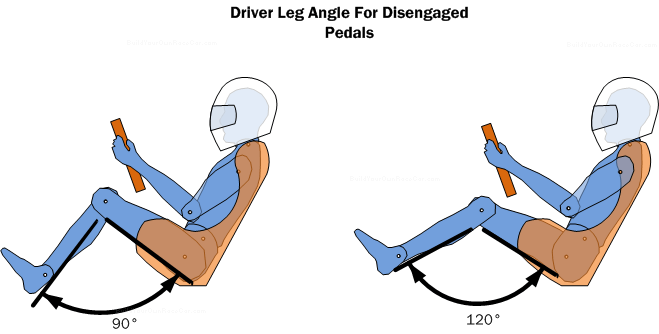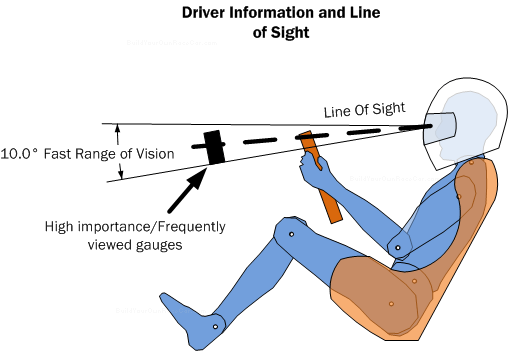 Page: 1 2
Page: 1 2
Car Driver Ergonomics Basics, How-To & Design Tips cont…
Control Positions cont…
Pedals
The pedals, like the steering wheel involve leverage within a limited space. The three most important factors affecting the pedals are:
-
Distance from the driver – Due to the limited motion of the legs, the pedals must be located at a proper distance from the driver to ensure they can be engaged without awkwardly stretching or pushing from cramped starting position. The comfort of the position is gauged by the driver, but generally speaking, a starting, unengaged angle for the legs should be no less than 90 degrees to ensure adequate leverage for long pedal travels. For shorter pedal travels or more laid back seating positions, angles of 120 degrees or more may be preferable. Diagram PED1 below shows 90 and 120 degree angles.

Diagram PED1. Driver leg angle for disengaged pedals. Starting leg angle depends on pedal travel, driver comfort and required leverage.
- Leverage Ratio – Like a typical lever, the travel of the pedal that results from its leverage ratio must be taken into account when designing the pedals and the pedal distance from the driver (Point #1 above). Too long a travel and the motion may become fatiguing. Too short a pedal travel and the extra force needed may become fatiguing.
- Control Sensitivity – Pedal travel again comes into play when we speak about sensitivity. The pedal travel must be tuned to the precision required for optimal control. For instance, a very short travel gas pedal might be difficult to control precisely on a bumpy surface. A short travel clutch pedal may make the clutch too quick to “bite” and cause bogging.
Information/Gauges/Communications
In addition to the road the driver sees and feels through the seat, pedals and steering wheel, there is often a need for information that helps the driver to optimize their driving style and actions.
The information needed must address the nature of the vehicle and racing (if applicable). For example, a fuel flow gauge would be useful in racing that relies heavily upon managing fuel consumption. If a driver and co-driver or pit crew need to communicate, then a communication system would be in order. If switches are needed to control aspects of the vehicle, they will need to be considered in the driver information system design.
Road or High-Performance Street machines have similar needs to racing cars, but the focus of information is generally on ensuring “Nominal” operation—that is, you’re not running out of fuel, your engine cooling system is working, you’re shifting at the right RPM, etc.
-
Gauges – The most critical and frequently viewed gauges in a race or high-performance vehicle should be placed in or very near to the driver’s line of sight. Within a 5-10° range of the line of sight, as shown in diagram IGC1 below, the driver can quickly see the gauge readouts while still keeping their eyes on the road.

Diagram IGC1. The driver’s line of sight includes an angle range where their vision is capable of quick gauge assessment which limits the duration away from focusing on driving.
-
Radios in Racing – Driver-to-co-driver communications should use high quality noise cancellation radio systems as the communication needs to be very clear in a co-operative racing situation like Rally. In Driver-to-Pit communications, the same principle applies, but incorporates a longer range transmission.
Radio type and antenna placement should be a design consideration, especially if the race course is over undulating terrain (outside of line-of-sight transmission). As the quality of the equipment will largely dictate the range and quality of the transmission, high quality noise cancellation radios are a must.
-
LCD displays/Data Acquisition – Steering wheel-based LCD/LED displays with data acquisition have become very popular as a single screen alternative to having multiple gauges.
Considerations for a designer using one of these displays should be for its brightness and anti-reflective properties. In direct sunlight a poorly lit display will wash-out. Consideration should also be given to the flexibility of the data acquisition for your sensor requirements and its ability to customize the display.
Cockpit Environment
The cockpit environment the occupants are in is largely dictated by the ride characteristics (Rough, smooth), the temperature (heat transfer from components like engine), the air flow, and the noise level.
Ensuring the occupants have the optimal concentration involves designing the cockpit to regulate the environment to avoid extremes.
The roughness of the road surface can be isolated from the occupants to some extent by damping their seating—the vehicle retains nimble handling, but the occupants are cushioned.
Driver cooling is often an issue, but can be resolved by using fresh, cool air ducted to the cockpit from the front of the vehicle and insulating the cockpit from engine and exhaust
Noise level can be controlled through earplugs or noise cancellation communications earphones.
Ergonomics Tips (2/2)
Determining driver position
Another helpful technique similar to that above is to use a mockup of the cockpit made from cardboard to determine the driver seating position. Use boards and supports under the driver to enable the driver to relax while keeping their head in the desired position for a good field of view. Use cardboard to model a steering wheel and gauge panel and use blocks to mark pedal positions and travel. The field of view should be rechecked with the “steering wheel” in position.
Consider driver comfort
Consider the comfort of the driver. A fully functioning cockpit can still leave the occupants tired, hot, and bruised if environmental factors are not considered.
Recommended Further Reading
27 1 20 3
 Page: 1 2
Page: 1 2